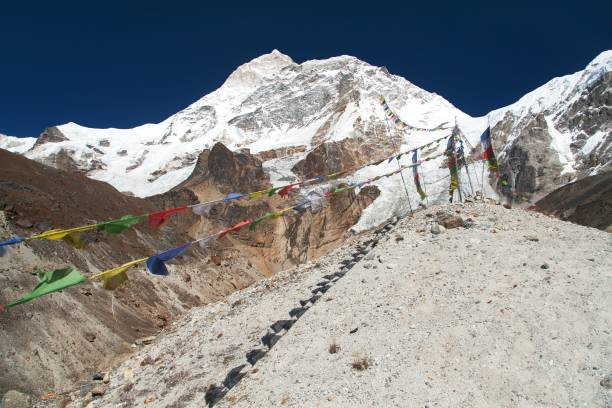Embarking on the Everest Base Camp (EBC) Trek in November offers trekkers a unique experience with crisp weather, clear skies, and fewer crowds, making it an excellent time to explore the majestic Himalayas. In this comprehensive guide, we will delve into everything you need to know about trekking to Everest Base Camp in November, from the highlights of the journey and essential packing lists to tips on physical fitness, preparation, and dealing with challenges like Lukla flight delays. Let’s embark on this epic adventure together!
November marks the end of the autumn trekking season in Nepal, offering trekkers pleasant weather conditions, stunning mountain views, and vibrant landscapes adorned with golden hues. As the temperatures begin to drop, November provides a comfortable trekking environment with clear visibility, making it an ideal time to immerse yourself in the natural beauty and cultural richness of the Everest region.
Highlights of Everest Base Camp Trek
The Everest Base Camp Trek is a legendary journey that takes trekkers through picturesque Sherpa villages, dense forests, and high-altitude landscapes before reaching the iconic base camp of Mount Everest. Highlights of the trek include panoramic views of Everest, Lhotse, Nuptse, and Ama Dablam, cultural encounters in Namche Bazaar, and the sense of achievement upon reaching the base camp and Kala Patthar for sunrise views.
- Jaw-Dropping Mountain Views: Witness iconic peaks like Mount Everest, Lhotse, and Ama Dablam up close.
- Cultural Immersion: Immerse yourself in Sherpa culture, visit monasteries, and explore traditional villages.
- Legendary Landmarks: Discover Namche Bazaar, Tengboche Monastery, and Kala Patthar along the trail.
- Adventure and Challenge: Trek through diverse terrain, cross high passes, and conquer rugged landscapes.
- Epic Achievement: Reach Everest Base Camp, stand in the shadow of Everest, and create lifelong memories.
Packing Lists For Everest Base Camp Trek
Packing for the 14 Days Everest Base Camp Trek requires careful consideration of essential gear and clothing to ensure comfort, safety, and enjoyment throughout the high-altitude adventure. Here is a comprehensive packing list to help you prepare for the trek to Everest Base Camp:
Clothing:
– Moisture-wicking base layers (tops and bottoms)
– Insulating mid-layers (fleece jacket, down jacket)
– Waterproof and windproof outer shell jacket
– Waterproof and windproof outer shell pants
– Thermal underwear (for higher altitudes)
– Hiking pants (convertible pants are versatile)
– Long-sleeve shirts (lightweight and breathable)
– T-shirts (quick-drying)
– Warm hat and sun hat
– Gloves or mittens (waterproof and insulated)
– Hiking socks (wool or synthetic blend)
– Undergarments
– Comfortable hiking boots (broken in and waterproof)
– Camp shoes or sandals
– Sunglasses with UV protection
– Buff or neck gaiter
– Bandana or headband
Gear and Equipment:
– Backpack (40-50 liters)
– Sleeping bag (four-season rating)
– Sleeping bag liner
– Trekking poles
– Headlamp or flashlight with extra batteries
– Water bottles or hydration system
– Water purification tablets or filter
– Snacks and energy bars
– Personal first aid kit
– Duct tape and repair kit
– Multi-tool or knife
– Camera or smartphone for photos
– Portable charger or power bank
– Trekking towel
– Sunglasses case
– Lightweight daypack for side trips
Toiletries:
– Toothbrush and toothpaste
– Biodegradable soap
– Moisturizer and lip balm with SPF
– Hand sanitizer
– Wet wipes
– Toilet paper
– Personal hygiene items
– Quick-dry towel
– Hairbrush or comb
Miscellaneous:
– Passport and permits
– Travel insurance documents
– Cash (Nepalese Rupees for tips and purchases)
– Snacks and comfort foods
– Journal or notebook with pen
– Reading material or e-reader
– Ziplock bags for organization
– Lightweight dry bags for packing
– Trekking map or guidebook
– Earplugs and eye mask for sleeping
Optional Items:
– Gaiters (for dusty or snowy conditions)
– Portable solar charger
– Trekking umbrella
– Compression socks
– Buff or face mask (for dust or cold)
– Leggings or shorts (for warmer weather)
– Thermos or insulated water bottle
Remember to pack light and efficiently, as you will be carrying your own gear during the trek. Layering clothing is key to adapting to changing weather conditions and temperatures along the trail. Be prepared for cold nights and warm days, as well as the possibility of rain or snow in the higher altitudes. Prioritize comfort, functionality, and versatility when selecting your gear and clothing items to ensure a successful and enjoyable trek to Everest Base Camp.
Guide and Porter
Hiring a knowledgeable guide and porter for the Everest Base Camp Trek is highly recommended, as they provide valuable support, local insights, and assistance with navigation, accommodation, and logistics. A guide can enhance your trekking experience by sharing cultural information, ensuring safety on the trail, and offering guidance on acclimatization, while a porter can help carry your gear, allowing you to focus on enjoying the journey.
Lukla Flight
The flight from Kathmandu to Lukla is a crucial part of the Everest Base Camp Trek, providing trekkers with access to the starting point of the adventure. While Lukla flights can be affected by weather conditions and delays, particularly during the autumn trekking season in November, staying informed about the flight status, maintaining flexibility in your itinerary, and being prepared for potential delays are essential to ensure a smooth start to your trek.
Best Time to Trek to Everest Base Camp
November is considered one of the best times to trek to Everest Base Camp, offering trekkers favorable weather conditions, clear skies, and breathtaking views of the Himalayan peaks. The crisp autumn air, mild temperatures, and vibrant landscapes of November create an idyllic trekking atmosphere, allowing you to fully appreciate the natural beauty and grandeur of the Everest region without the crowds of the peak season or the challenges of extreme cold.
Best Company: Sherpa Expedition and Trekking
Sherpa Expedition and Trekking is a trusted trekking company in Nepal that specializes in organizing memorable adventures to Everest Base Camp and other Himalayan destinations. With a team of experienced guides, reliable logistics, and a commitment to sustainable tourism practices, Sherpa Expedition and Trekking ensures a safe, authentic, and enriching trekking experience for adventurers of all levels. By choosing Sherpa Expedition and Trekking, you can embark on your Everest Base Camp Trek in November with confidence and peace of mind.
Best Insurance for Everest Base Camp Trek
Travel insurance is a vital component of trekking to Everest Base Camp, providing coverage for medical emergencies, evacuation services, trip cancellations, and lost or damaged belongings. When selecting insurance for your trek in November, it is essential to choose a comprehensive policy that includes high-altitude trekking coverage, helicopter evacuation options, and emergency assistance services, ensuring that you are prepared for any unforeseen circumstances during your Himalayan adventure.
Lukla Flight Delayed: Helicopter Option
In case of Lukla flight delays or cancellations due to inclement weather or other factors, trekkers have the option to charter a helicopter for transportation to Lukla or return to Kathmandu. Helicopter services offer a convenient and efficient alternative to domestic flights, allowing trekkers to minimize delays, adjust their itinerary, and ensure a seamless start to their Everest Base Camp Trek in November. It is advisable to stay in communication with your trekking company and be prepared to consider helicopter options if needed.
Food and Accommodation During the Trek
Accommodation along the Everest Base Camp Trek route in November primarily consists of teahouses, traditional lodges, and guesthouses that offer basic amenities such as cozy rooms, shared bathrooms, and hearty meals. Trekkers can enjoy a variety of local and international dishes, including Sherpa cuisine, dal bhat (rice and lentils), soups, and baked goods, providing nourishment and comfort after a day of hiking in the mountains. It is recommended to stay well-fed, hydrated, and embrace the hospitality of the local communities along the trekking route.
Physical Fitness and Preparation
Preparing for the Everest Base Camp Trek in November requires a good level of physical fitness, endurance, and mental preparation to tackle the high-altitude terrain and challenges of the Himalayas. Prior training, including cardiovascular exercises, strength training, and hiking with a loaded backpack, can help improve your fitness levels and readiness for the trek. It is crucial to acclimatize gradually, stay hydrated, and listen to your body throughout the journey to ensure a safe and enjoyable trekking experience in November.
Conclusion
Trekking to Everest Base Camp in November is a remarkable journey that offers trekkers a unique opportunity to explore the stunning landscapes, cultural heritage, and natural wonders of the Everest region in a tranquil setting. With proper preparation, essential gear, and the support of experienced guides and porters, you can embark on an unforgettable adventure through the heart of the Himalayas, creating memories that will last a lifetime. So gear up, embrace the spirit of adventure, and set out on your Everest Base Camp Trek in November, where every step brings you closer to the top of the world and a deeper connection to the magic of Nepal’s mountains.


